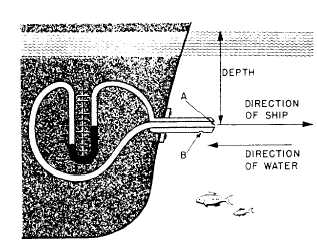and form bubbles in the veins. Any sudden release in the
pressure on a fluid results in the freeing of some gases
that are dissolved in the fluid. You have seen this happen
when you suddenly relieve the pressure on a bottle of
pop by removing the cap. The careful matching of
hydrostatic pressure on the diver by air pressure in the
diving suit is essential if diving is to be done at all.
Determining Ship’s Speed
Did you ever wonder how the skipper knows the
speed the ship is making through water? The skipper can
get this information by using several instruments-the
patent log, the engine revolution counter, and the
pitometer (pit) log. The “pit log” operates, in part, by
hydrostatic pressure. It really shows the difference
between hydrostatic pressure and the pressure of the
water flowing past the ship-but this difference can be
used to find ship’s speed.
Figure 10-4 shows a schematic drawing of a
pitometer log. It consists of a double-wall tube that
sticks out forward of the ship’s hull into water that is not
disturbed by the ship’s motion. In the tip of the tube is
an opening (A). When the ship is moving, two forces or
pressures are acting on this opening: (1) the hydrostatic
pressure caused by the depth of the water above the
opening and (2) a pressure caused by the push of the ship
through the water. The total pressure from these two
forces transmits through the central tube (shown in
white on the figure) to the left-hand arm of a manometer.
In the side of the tube is a second opening (B) that
does not face the direction in which the ship is moving.
Opening B passes through the outer wall of the
double-wall tube, but not through the inner wall. The
only pressure affecting opening B is the hydrostatic
figure 10-4.-A pitometer log.
pressure. This pressure transmits through the outer tube
(shaded in the drawing) to the right-hand arm of the
manometer.
When the ship is dead in the water, the pressure
through both openings A and B is the same, and the
mercury in each arm of the manometer stands at the
same level. However, as soon as the ship begins to move,
additional pressure develops at opening A, and the
mercury pushes down in the left-hand arm and up into
the right-hand arm of the tube. The faster the ship goes,
the greater this additional pressure becomes, and the
greater the difference will be between the levels of the
mercury in the two arms of the manometer. You can read
the speed of the ship directly from the calibrated scale
on the manometer.
Since air is also a fluid, the airspeed of an aircraft
can be found by a similar device. You have probably
seen the thin tube sticking out from the nose or the
leading edge of a wing of the plane. Flyers call this tube
a pitot tube. Its basic principle is the same as that of the
pitometer log.
HYDRAULIC PRESSURE
Perhaps your earliest contact with hydraulic
pressure was when you got your first haircut. The
hairdresser put a board across the arms of the chair, sat
you on it, and began to pump the chair up to a convenient
level. As you grew older, you probably discovered that
the gas station attendant could put a car on the greasing
rack and-by some mysterious arrangement-jack it
head high. The attendant may have told you that oil
under pressure below the piston was doing the job.
Come to think about it, you’ve probably known
something about hydraulics for a long time.
Automobiles and airplanes use hydraulic brakes. As a
sailor, you’ll have to operate many hydraulic machines.
You’ll want to understand the basic principles on which
they work.
Primitive man used simple machines such as the
lever, the inclined plane, the pulley, the wedge, and the
wheel and axle. It was considerably later before
someone discovered that you could use liquids and
gases to exert forces at a distance. Then, a vast number
of new machines appeared. A machine that transmits
forces by a liquid is a hydraulic machine. A variation of
the hydraulic machine is the type that operates with a
compressed gas. This type is known as the pneumatic
machine. This chapter deals only with basic hydraulic
machines.
10-4


